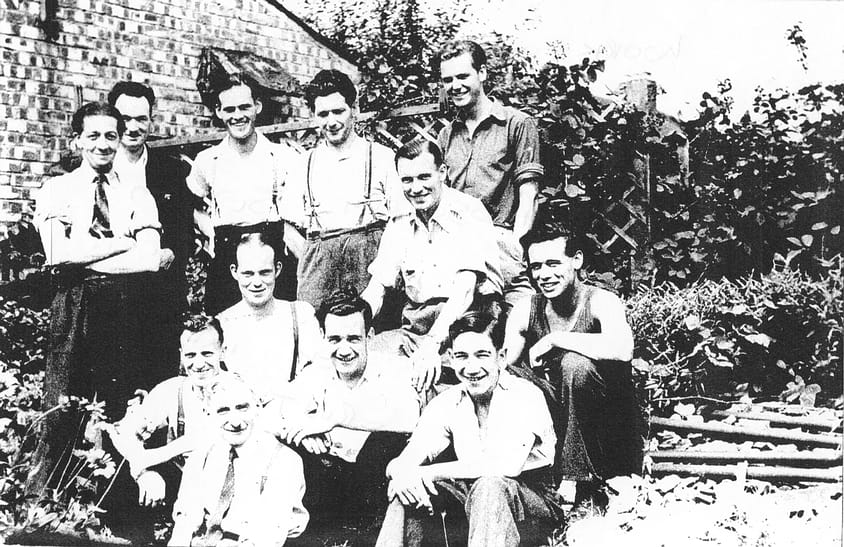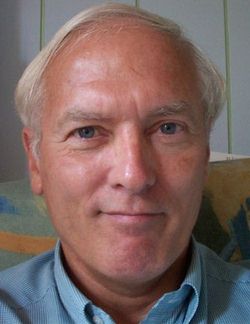Teesmade Co and Teesmade Engineering

From about 1934 George Absolom traded as Teesmade Co, mirroring the name of his invention, the Teesmade. Unfortunately no records remain at Companies House for Teesmade Co.
Robert Absolom believes that following the Teesmade Cabinet his father developed a model with a tapered frontage, both kettle and teapot being situated behind the clock. Then on August 21st 1935 Absolom, together with George Herbert Johnson of Hampton Works, Sheen Lane, Mortlake, SW14, applied for a patent for a new design, patent no 440941. George reached an agreement with L G Hawkins to manufacture these tea makers for them. The unit, branded as the Tecal, was manufactured by George Absolom from 1936 until the beginning of World War 2 in 1939.
During the war period as a result of contracts involving a variety of metal working, George Absolom changed the name of his company from Teesmade Co to Teesmade Engineering. The photo below shows the workforce at the rear of 52 Lansbury Drive around 1947-48, with Robert Absolom seated centre right, and Reg Juster seated at front.

At first the company concentrated on making electric kettles and tumbler elements for hot drinks, which were in greater demand than luxury items. In 1949 Absolom and Hawkins jointly applied for patent number 616208, for an automatic thermal cut-out for an electric heating element. In 1954 George Absolom submitted a patent application, number 645238, for improvements relating to thermally-actuated electric connector-plug ejectors.
Tea makers returned to Lansbury Drive in around 1954. The first models to appear were the Teaboy and the Teaboy Junior. These were distributed through wholesalers. In 1954 Teesmade Engineering entered into an agreement with Pifco, to produce their two pre-existing models in the Pifco name. These were the Pifco 1045 and 1047. Later they added the Pifco 1049.
By 1956 George was suffering from emphysema. George’s son, Robert, married Gwen in 1956, and she was employed in the family business, handling the paperwork in the conservatory. Robert and Gwen were expecting their first child, a daughter, when George’s illness worsened. He made the decision to transfer the company to his son’s name (Robert W Absolom). George remained at hand and involved in the business until eventually he became so ill that he was hospitalised. On visiting him in hospital, George told Robert that he had left him the business, however, after his death in February 1957 no will was found.
Robert continued to run the business at number 52, but his stepmother Peggy was in favour of closing the business to clear the estate debts and leave the house unencumbered. The Monks may have added to the pressure as they intended to sell Number 54 on Mr Monk’s retirement. Robert was very much against closing the business, and calling upon solicitors and accountants to back his claim, he carried on trading, successfully clearing the debts and starting to make a profit. His son was born in 1960.
One morning around 1962 Robert Absolom was met at the door by his foreman, who had been suborned by his stepmother Peggy and refused entry. This was supported by a solicitor’s letter and confirmation that the bank had been instructed accordingly. After this Robert Absolom pursued a career in sales and had no further involvement with the family or tea makers.

We are lucky to have an account of Robert’s final years in the business from former employee Colin Berry (pictured in 1959). In 1961 Colin supplemented his pocket money by working at Teesmade Engineering, in the garage at Lansbury Drive Hayes. He writes:
“I started first as a full timer in the school summer hols, earning two bob an hour as I recall, then continued as a part-timer on Saturday mornings for a year, until I was deemed to be surplus to requirements. I can tell you quite a bit about that amazing operation that turned sheet metal and wood miraculously into the end-product. The amazing part was seeing the coppery-looking kettles going off to the platers, with solder and green corrosion ( the latter was supposed to be got rid of, which was well nigh imposssible). They came back all chrome-plated, which made it all worthwhile.
“I have vivid recollections of half a dozen or so of the pressing and cutting operations, including the amazing lever set up in a deconsecrated church hall in Cranford. The job I liked most (the neighbours might disagree) was getting rid of the protective lacquer coating on the heating elements. This involved wiring them up in series, and flicking a switch, which sent a large current through them, producing billows of smoke. There was an extractor fan at the end of the garage where this job was done, that sent the nasty smoke into the back garden.
“First I should say that I was just given particular jobs to do, and was never taken on the “grand tour”. That was impossible anyway. It wasn’t like a car assembly plant where you can follow things along a conveyor belt. The jobs being done at any time would depend on who was in that particular day, and which stack needed moving on. And certain jobs were done somewhere else. Soldering of the tops and sides of the kettle bodies was a case in point. I think it was done elsewhere, but still fairly local, in keeping with the ‘cottage industry’ nature of the operation.
“As you came into the garage the first thing you saw in front of you was a press which as I recall vaguely cut some slots from a blank of metal. It was probably to make the end support cum housing for the electrical element. Irrespective, the force came from yanking a vertical handle attached to a rotating horizontal arm, at each end of which sat two heavy steel balls. The balls sat on a short spike, in other words relying on gravity to hold them in place. Different jobs needed different sized balls, if you’ll pardon the expression, (as you see, I’m not an engineer by profession, and am struggling to give a word picture). That’s why they were sitting there with very little to hold them in place – so one size of ball could easily be replaced by another.
“It took two to operate this machine, one seated the other standing. I was standing, and the two of us were deep into pop music. John Leyton was playing on the radio (Johnny, remember me …..). God knows how it happened but as the arm whipped round, one of those balls came off its spike, narrowly missed my co-worker ( whose name I’ve long since forgotten) and crashed to the ground. Safety at work in those days was largely a matter of self-preservation. I never recall seeing a factory inspector.
“The boss (Robert Absolom) was just feet away. He always did the final adjustments to the spring base of finished teasmades, for which he had a stack of ancient pennies). He was none too pleased by this incident, needless to say, and reprimanded us for talking too much, instead of concentrating on the job in hand. I remember him as a calm and dignified chap, who always radiated quiet confidence.
“I always remember his answer to the new recruit when asked to explain what a fuse was. He said “Tell me, have you ever heard the expression that a chain is only as strong as its weakest link?” He hardly needed to say another word. As someone who’s done a fair amount of teaching in his time, I’ve always remembered that as a fine example of economy in words!
“The distinctive feature of the kettles we made were the grip on the cap. It was made from a cylinder of black ebonite (hard vulcanised rubber). I used to be puzzled by tea makers that came back for repair. The grip, instead of being black, was often shiny yellow brown, as if it were made from resin or amber. I did a web search and found that it’s a characteristic of ebonite to turn brown when exposed to light!
“Each lid had to make a perfect air and steam-tight fit. The only relief for pressure was through the pin-hole vent. ( Science bit: otherwise there would be insufficient build up of pressure to drive water out the kettle when it came to the boil.)
“Because of manufacturing variation we had to match up lids to kettles, which was both time-consuming and unhygienic. Yes, unhygienic, because no kettle was allowed to leave the workshop without someone (usually me!) having done the blow test. This involved screwing a lid on, blocking off the vent with a finger and blowing down the spout. If, as often happened, the lid was not airtight, one had to try another, and another, and another, until one found a fit. After a while one ended up with a heap of lids that didn’t seem to fit any kettles. I had a name for them, which I won’t mention here. Let’s call them ‘orphans’. The foreman – a formidable guy who could not only bend 6 inch nails, but, as a pièce de résistance, then straighten them out again – would start to get agitated when there were too many orphans cluttering up my bench. He would then insist that each new batch of kettles be tested with orphans first, which led to much futile huffing and puffing, not to say profaning on my part. Desperate situations call for desperate remedies. Each day on my way home I passed a bit of waste land. Whilst orphan kettle lids did not possess quite the aerodynamic properties of frisbees, I developed a technique for getting them into the yonder long grass.
“To begin with, I dispatched them at a rate of one per day, maximum. No one seemed to notice that the heap of orphans was no longer getting bigger. You can probably guess how this story ends. With time I began to get over-confident, and was ridding myself of the critters in two and threes. My sins finally found me out. Nail-bender took me round to the conservatory (sorry, office) where I was told that, sadly, my services were no longer required. No reason was given, and I knew better than to ask.
“Postscript: Future archaeologists excavating in Hayes End may one day decide that between the Iron Age and the late 20th century Plastics Age came a brief flowering of an Ebonite Era.”

Colin must have been infected with a teasmania which has remained throughout his life. He concludes:
“More and more memories are coming back. What helped to keep them alive was the fact that I did some secondary school teaching in the 90s, and for some weeks had my teasmade on the bench. When the kids got bored and restless with the new fangled National Curriculum, I’d fill the kettle, switch in on, give out a worksheet, and assemble them at the front as it came up to the boil.
“The physical principles that come into play when it boils are amazing. I used to ask them why there’s a small pinhole vent in the screw cap lid, and why it must not be too big! And why was the spout below rather than above the water level in the kettle ? That got the buggers thinking! The head of department used to look somewhat askance when Berry did his teasmade thing, but I had the last laugh. That same year a question came up on the GCSE combined science paper on – guess what – the teasmade? Perhaps I should have kept a copy: a vital part of our national heritage gone to waste!”
Despite Peggy’s claim that she wished to close the company, the business continued after Robert’s departure, trading as Teeboy Engineering.
